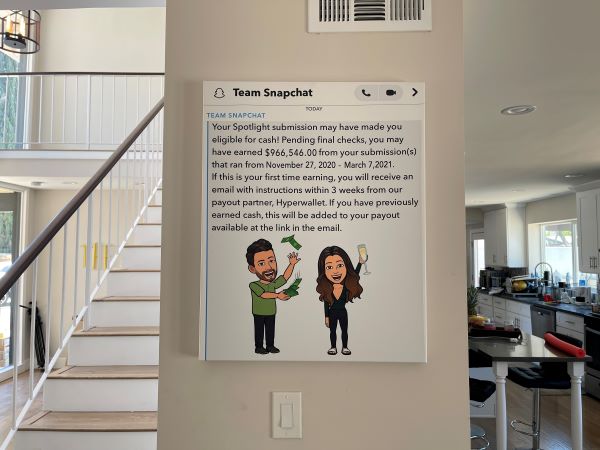In US content creator economy boom, big tech battles for online talent
Katie Feeney, an 18-year-old from Olney, Maryland, was in her calculus class on Zoom in November when she learned that a week of posting skits and unboxing videos on Snapchat earned her $229,000. Her $1.4 million in total earnings over the past seven months will be enough to pay for her college tuition at Penn State to study business.
Portland-based personal trainer Julian Shaw dug himself out of $18,000 in credit card debt during the pandemic by selling fitness education videos “with a bit of sex appeal,” on OnlyFans, a content subscription site favored by sex workers paid directly by followers for posts.
In the last year, major social media companies have raced to announce dozens of features aimed at attracting creators, an estimated 50 million people like Feeney and Shaw who range from internet personalities posting beauty tutorials on YouTube and TikTok to independent journalists selling newsletter subscriptions on Substack to video gamers live-streaming on Twitch.

Katie Feeney, an 18-year-old social media personality, poses with her phone at a shopping center where she films many of her videos, in Gaithersburg, Maryland, U.S., May 25, 2021. REUTERS/Erin Scott
The popularity of upstarts like TikTok, whose tools have helped unknowns generate massive audiences and whose $2 billion creator fund helped drive attention to the rapidly expanding field, has set off an arms race among big incumbents like Facebook, Twitter and Alphabet-owned YouTube to lure the most popular creators, sometimes called influencers. They have introduced new features, funds and subscription or tipping tools to earn money from fans.
The trend means changes for ordinary social media users too. They will face more requests or requirements to pay for content that is now available for free. And the new tools give them opportunities to engage more directly with influencers.
The companies’ race to attract and keep creators represents an evolution of the social media creator economy, which for years was based around earning money through ad revenue sharing and brand sponsorships. The sponsorship market reached $8 billion in 2019 and is projected to hit $15 billion by next year, according to influencer marketing firm Mediakix.

A framed screenshot of the earnings Dominic Andre, a mental health therapist turned TikTok science video creator, and his girlfriend made in the past year from Snapchat – $970,000 – is shown in their home in Los Angeles, California, U.S., May 24, 2021. Picture taken May, 24, 2021 Dominic Andre/Handout via REUTERS
“The power has shifted away from the platforms to the creators,” said Josh Constine from venture capital firm SignalFire, which invests in one-year-old popular audio chat app Clubhouse. “The platforms all stepped up and realized that they were in grave danger of losing their labor force, if they didn’t add these features.”
Vine’s experience is a cautionary tale, Constine said. The briefly hot short-form video app purchased by Twitter was considered a predecessor to TikTok but died after creators left the service because it did not provide ways for them to earn money.
Facebook, which long lacked monetization features, has announced a slew of creator-focused features and is paying video gamers as it builds out Facebook Gaming. Instagram head Adam Mosseri said this week the app was “exploring” content subscriptions, which would be a first for the Facebook-owned app.
Even Twitter is racing to catch up by teasing “Super Follow,” a feature for users to pay popular Twitter figures for exclusive content, and announcing paid ticketing for its new live audio chatrooms. This month it also launched a way for audiences to make online payments to a user’s “Tip Jar.”
When Los Angeles-based photographer Nesrin Danan learned in May that she could earn tips on the site, she tweeted to her 27,000 followers: “I have tweeted 40,000 times since 2009 for FREE so if you have ever let out even the slightest chuckle at my unhinged nonsense I’m expecting at least $1.” She said she made a few hundred dollars this month.
THE CREATOR CHASE
Social media personalities are parlaying success on one platform into earnings on another. This reduces their dependence on one app, where they could be vulnerable to algorithm changes or moderation decisions.
To keep creators engaged, tech platforms have dedicated funds to pay users who produce the most engaging content. Snapchat says it has spent $130 million since November financing contributors on its short-form feature “Spotlight.”

Dominic Andre, a mental health therapist turned TikTok science video creator, poses for a photo outside his home in Los Angeles, California, U.S., March 17, 2021. Picture taken March 17, 2021. Dominic Andre/Handout via REUTERS
Dominic Andre, a mental health therapist turned TikTok science video creator, said he long had his eye on getting involved with Snapchat’s programs. A screenshot of the earnings he and his girlfriend made in the past year from Spotlight – $966,546 – is framed in the Los Angeles house that the money helped them buy.
Feeney, who initially grew a following of over 5 million on TikTok before expanding to Snapchat, says she was recruited by YouTube to join a beta test for its new TikTok clone Shorts.
Tech journalist Casey Newton, who left Vox Media to write his newsletter “Platformer” on Substack in September, said companies are also offering more favorable terms for creators than they had previously.
One example is Facebook’s plans to let writers on its upcoming newsletter product export the email addresses of their readers if they decide to use a different publishing service, he said.
Related Articles
“I think that speaks to how much power creators have in this moment,” Newton said.
YouTube, which has long provided ways for video posters to make money and says it has paid over $30 billion to creators and media organizations in the last three years, recently launched a $100 million fund for Shorts creators.
Jamie Byrne, YouTube’s senior director of creator partnerships, said creators asked for such a fund if they were to make their YouTube channel the main home for their followings.
“Creators are taking their rightful place in the center of the creator economy universe,” he said. “We need to be their home base.”
(Reporting by Elizabeth Culliford and Sheila Dang; editing by Kenneth Li and Cynthia Osterman)

